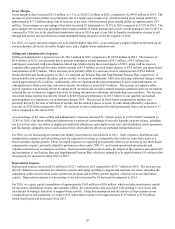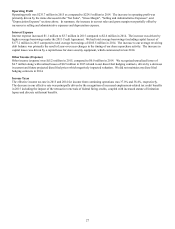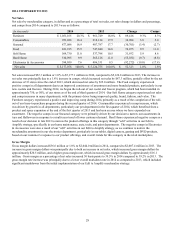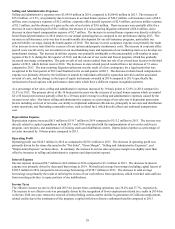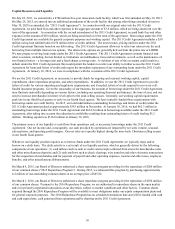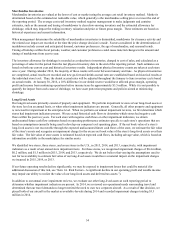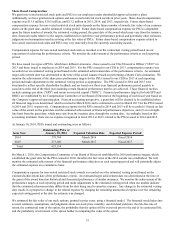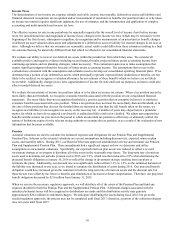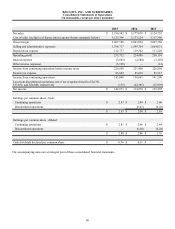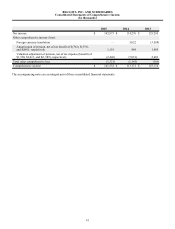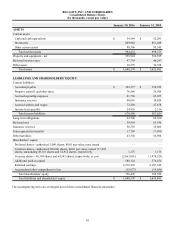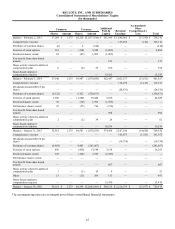Big Lots 2015 Annual Report Download - page 113
Download and view the complete annual report
Please find page 113 of the 2015 Big Lots annual report below. You can navigate through the pages in the report by either clicking on the pages listed below, or by using the keyword search tool below to find specific information within the annual report.36
Income Taxes
The determination of our income tax expense, refunds receivable, income taxes payable, deferred tax assets and liabilities and
financial statement recognition, de-recognition and/or measurement of uncertain tax benefits (for positions taken or to be taken
on income tax returns) requires significant judgment, the use of estimates, and the interpretation and application of complex
accounting and multi-jurisdictional income tax laws.
The effective income tax rate in any period may be materially impacted by the overall level of income (loss) before income
taxes, the jurisdictional mix and magnitude of income (loss), changes in the income tax laws (which may be retroactive to the
beginning of the fiscal year), subsequent recognition, de-recognition and/or measurement of an uncertain tax benefit, changes
in deferred tax asset valuation allowances and adjustments of a deferred tax asset or liability for enacted changes in tax laws or
rates. Although we believe that our estimates are reasonable, actual results could differ from these estimates resulting in a final
tax outcome that may be materially different from that which is reflected in our consolidated financial statements.
We evaluate our ability to recover our deferred tax assets within the jurisdiction from which they arise. We consider all
available positive and negative evidence including recent financial results, projected future pretax accounting income from
continuing operations and tax planning strategies (when necessary). This evaluation requires us to make assumptions that
require significant judgment about the forecasts of future pretax accounting income. The assumptions that we use in this
evaluation are consistent with the assumptions and estimates used to develop our consolidated operating financial plans. If we
determine that a portion of our deferred tax assets, which principally represent expected future deductions or benefits, are not
likely to be realized, we recognize a valuation allowance for our estimate of these benefits which we believe are not likely
recoverable. Additionally, changes in tax laws, apportionment of income for state and local tax purposes, and rates could also
affect recorded deferred tax assets.
We evaluate the uncertainty of income tax positions taken or to be taken on income tax returns. When a tax position meets the
more-likely-than-not threshold, we recognize economic benefits associated with the position on our consolidated financial
statements. The more-likely-than-not recognition threshold is a positive assertion that an enterprise believes it is entitled to
economic benefits associated with a tax position. When a tax position does not meet the more-likely-than-not threshold, or in
the case of those positions that do meet the threshold but are measured at less than the full benefit taken on the return, we
recognize tax liabilities (or de-recognize tax assets, as the case may be). A number of years may elapse before a particular
matter, for which we have de-recognized a tax benefit, is audited and fully resolved or clarified. We adjust unrecognized tax
benefits and the income tax provision in the period in which an uncertain tax position is effectively or ultimately settled, the
statute of limitations expires for the relevant taxing authority to examine the tax position, or as a result of the evaluation of new
information that becomes available.
Pension
Actuarial valuations are used to calculate the estimated expenses and obligations for our Pension Plan and Supplemental
Pension Plan. Inherent in the actuarial valuations are several assumptions including discount rate, expected return on plan
assets, and mortality tables. During 2015, our Board of Directors approved amendments to freeze and terminate our Pension
Plan and Supplemental Pension Plan. These amendments had a significant impact on how we determine and utilize
assumptions in our actuarial valuations. Specifically, our expected return on plan assets was reduced to reflect a revised
investment strategy as we prepare to distribute all of the assets in the reasonably near future. The long-term rate of return on
assets used to determine net periodic pension cost in 2015 was 5.2%, which was then reduced to 2.8% when determining the
projected benefit obligation at January 30, 2016 to reflect the change in investment strategy resulting from our plans to
terminate the plans. Additionally, our discount rate was significantly reduced from 3.3% to 1.2%, as the estimated duration of
the liability was shortened to one year, as we intend to complete the distribution of assets during 2016. Our projected benefit
obligation would have increased given the reduction in both the long-term rate of return on assets and the discount rate, but
those factors were offset by the freeze in benefits and elimination of increases in future compensation. Therefore, our projected
benefit obligation decreased by $2.8 million from January 31, 2015.
When we receive the necessary regulatory approvals, we will distribute all of the assets of the Pension Plan and fund any
required shortfall for both the Pension Plan and the Supplemental Pension Plan. Settlement charges associated with the
unrealized actuarial losses will be recognized as distributions are made and this distribution activity may generate
approximately $26.4 million in settlement charges. We anticipate distributing the assets during fiscal 2016, but given the
needed regulatory approvals, the process may not be completed until fiscal 2017; therefore, a portion of the settlement charges
may not occur until fiscal 2017.


